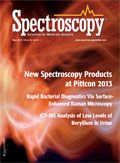Appendix V: Imaging
Additional information from the imaging section of the Pittcon Review article.
Manufacturer: Princeton Instruments
Product name: IsoPlane spectrograph
UV-vis, Raman spectrometer
New this year: Imaging spectrograph.
Used for: Lab analysis
Measurement Modes: Transmission, reflectance, absorbance, fluorescence, emission, Raman scattering.
Special Features: A practically perfect optical aberration-free imaging spectrograph. Schmidt-Czerny-Turner spectrograph with zero field astigmatism and greatly reduced coma and spherical aberration.
Software: Available as separate product, may be used in other equipment.
Suggested applications: Raman scattering, atomic emission including libs, multichannel spectroscopy, microspectroscopy, Fourier-domain spectroscopy, fluorescence and fluorescence imaging, carbon nanotubes and quantum dots, biomedical imaging
Primary benefits: the IsoPlane gives improved imaging, higher spectral and spatial resolution, and spectra with improved signal-to-noise ratio compared to its competitors. With improved focusing, more photons hit fewer pixels, increasing the resolution and the signal-to-noise ratio of spectra.
Unique features: A practically aberration free imaging spectrograph that is easy to align and focus, grating turret has three positions, three turrets can be used interchangeably, giving up to 9 possible gratings.

Best of the Week: What You Missed from Pittcon and AAFS
March 14th 2025Top articles published this week include a video interview on the role of near-infrared (NIR) spectroscopy in food and bioanalysis, a recap of an important session at Pittcon, and a dynamic video that summarizes the highlights of the American Academy of Forensic Sciences (AAFS) Conference.
Raman Spectroscopy Aflatoxin Detection Enhances Peanut Safety
March 11th 2025A research team from Jiangsu University has developed a Raman spectroscopy-based method to detect aflatoxin B1 (AFB1) in peanuts with improved accuracy and efficiency. By employing a two-step hybrid strategy integrating backward interval partial least squares (BiPLS) and variable combination population analysis (VCPA), the new model significantly enhances the precision of AFB1 detection, providing a more reliable approach for food safety monitoring.
Advancing NIR and Imaging Spectroscopy in Food and Bioanalysis
March 11th 2025Our full-length interview with Huck covers more than just NIR spectroscopy in food and bio analysis. Spectroscopy sat down with Huck to also discuss current trends going on in spectroscopy, delving into what challenges spectroscopists face today and how they can solve these concerns.